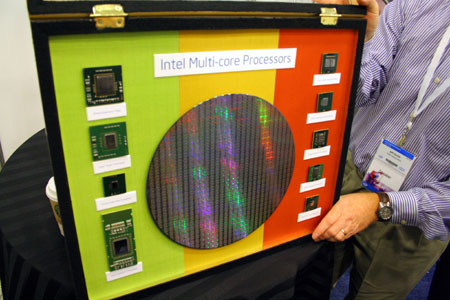Last summer was the 'summer of servers' according to Intel, since it renewed its complete offering of server processors. It all started on May 23 with Dempsey, a 65nm dual-core Netburst Xeon that was launched along with a new chipset, with more than twice the amount of bandwidth as the previous generation. A little over a month later – on June 26 to be precise - Woodcrest was released, based on the new Core architecture and busses that were 25% quicker. July 18 saw the launch of Itanium, with the introduction of the dual-core Montecito, a chip with 24MB of L3 cache and over 1,7 billion transistors. Another month went by and on August 29 a new Xeon MP came out under the code name Tulsa, with 16MB of L3 cache. Clovertown – the fist quad-core Xeon – was delivered on November 14 as an afterbirth.

Intel has put in extra hours in the second half of the past year to overtake the competition. All that AMD managed to do to counter that was the introduction of the Socket F models (which, except for the 2.8GHz flavour did little to increase performance), and a price cut. Although that does not mean that AMD did badly in terms of contracts it won and market share – quite the contrary – it does mean that Intel has a lot more weight than it had for a long time. Although the quad-core Opteron Barcelona might tip the balance again in six months, Intel is ahead in many benchmarks at the moment.
Before we turn to our own comparative database test, we shall show the current state of affairs in database country. For completeness: although the 'non-tweakers.net'-scores that have been collected below are practical scores, they have been measured independently This means that there may be differences in a number of parameters of the various system configurations. It also means that better results are not always fully due to hardware improvements: after all, the software that comes with it also tends to get improved. But it is safe to assume that each system builder does his best to achieve the best results, and with this in mind the scores may be considered indicative.
![]() SPEC CPU
SPEC CPU
We start with SPECint_rate and SPECfp_rate, two benchmarks designed to measure raw processor performance. The 'INT' (integer) suite consists of a compiler, chess programs, compression and text processing, while the 'FP' (floating point) suite contains, among others, face recognition, neural networks and physics as well as chemistry simulations. All subtests are based on software that is also used 'in real life', but the code has been altered in certain spots to minimize, among other things, hard disk load and improve portability to other platforms.
The addition 'rate' indicates that we are not dealing with a test of a single chip, but of all cores in a system simultaneously, which makes bandwidth a significant factor. 'Peak' indicates that the compiler may be tuned to the maximum extent. A standard run demands that everything is built with the same setting, but for a 'peak' run every individual test may have its own parameters. Since Clovertown-servers have a unique configuration of eight cores in two socket, we compare it to systems that have eight cores in four sockets, as well as configurations with four cores in two sockets. In the integer benchmark we see that the new Xeon beats the competition: the Core architecture already proved itself to be good at these sort of tasks, but improving the best scores of four socket systems is an impressive achievement.
| Opteron 8220 | 4 | 2,8GHz | Santa Rosa | |||||||
| Xeon MP 7140 | 4 | 3,4GHz | Tulsa | |||||||
| Power5 | 4 | 1,9GHz | ||||||||
| Itanium 2 9050 | 4 | 1,6GHz | Montecito | |||||||
| Xeon MP 7041 | 4 | 3,0GHz | Paxville | |||||||
| 2 | 2,66GHz | Clovertown | ||||||||
| Xeon 5160 | 2 | 3,0GHz | Woodcrest | |||||||
| Opteron 2280 | 2 | 2,8GHz | Santa Rosa | |||||||
| Power5+ | 2 | 2,1GHz | ||||||||
| Xeon 5080 | 2 | 3,73GHz | Dempsey | |||||||
| Xeon DC | 2 | 2,8GHz | Paxville | |||||||
In the FP benchmark it turns out that the quad-core doesn't do so well, which is presumably due to its limited bandwidth – which is something that SPECfp_rate can't get enough of. But we do see that Intel has made steady improvements over the course of the year, from a meagre 40.3 with the Paxville to a respectable score of 104. That is still lower than the Opteron (although it would be a narrow victory without compiler magic) but the problem is that AMD still has the step to quad-core architecture and 128 bit computation units ahead, while Clovertown has already been there. The Itanium can keep up, but this test remains one of AMD's favourites.
| Power5 | 4 | 1,9GHz | ||||||||
| Itanium 2 9050 | 4 | 1,6GHz | Montecito | |||||||
| Opteron 8220 | 4 | 2,8GHz | Santa Rosa | |||||||
| Xeon MP 7140 | 4 | 3,4GHz | Tulsa | |||||||
| Xeon MP 7041 | 4 | 3,0GHz | Paxville | |||||||
| Power5+ | 2 | 2,1GHz | ||||||||
| Itanium 2 9050 | 2 | 1,6GHz | Montecito | |||||||
| Opteron 2220 | 2 | 2,8GHz | Santa Rosa | |||||||
| 2 | 2,66GHz | Clovertown | ||||||||
| Xeon 5160 | 2 | 3,0GHz | Woodcrest | |||||||
| Xeon 5080 | 2 | 3,73GHz | Dempsey | |||||||
| Xeon DC | 2 | 2,8GHz | Paxville | |||||||
